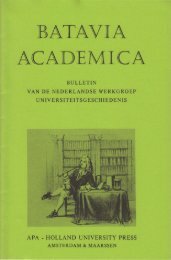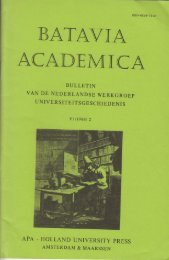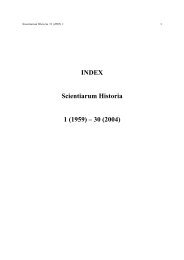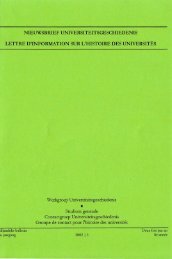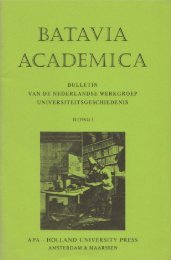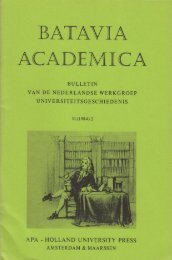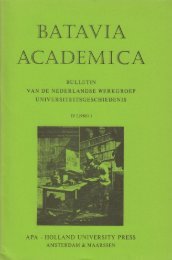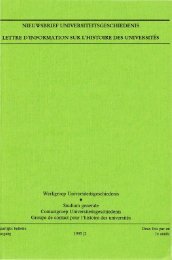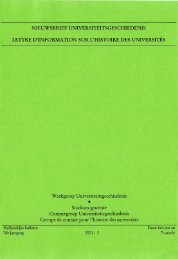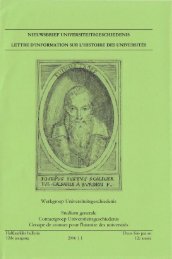the ocular harpsichord of louis-bertrand castel - Gewina
the ocular harpsichord of louis-bertrand castel - Gewina
the ocular harpsichord of louis-bertrand castel - Gewina
Create successful ePaper yourself
Turn your PDF publications into a flip-book with our unique Google optimized e-Paper software.
Castel's <strong>ocular</strong> <strong>harpsichord</strong> 63<br />
The tones are measured out to it, accounted to it, harmonically, melodically; an<br />
invisible, arousing Spirit talks with our feeling self in succession."'*<br />
The later writings <strong>of</strong> Herder seem to fit in with <strong>the</strong> <strong>the</strong>n freshly blossoming<br />
German Romantic Naturphilosophie, in which <strong>the</strong> unity <strong>of</strong> nature and <strong>the</strong><br />
connectedness <strong>of</strong> man with nature were much emphasized. One <strong>of</strong> <strong>the</strong> earliest<br />
books that made <strong>the</strong>se ideas popular outside Germany was De TAllemagne, by<br />
Madame de Stael, who had spent most <strong>of</strong> <strong>the</strong> exile Napoleon had forced her<br />
into in Germany. In her book she brought back, unknowingly, <strong>the</strong> <strong>ocular</strong><br />
<strong>harpsichord</strong> to France, as she described how<br />
<strong>the</strong> analogies <strong>of</strong> <strong>the</strong> various elements <strong>of</strong> physical nature toge<strong>the</strong>r reveal <strong>the</strong> supreme law <strong>of</strong><br />
creation, variety in unity and unity in variety. What is more astonishing than, for instance, <strong>the</strong><br />
rapport between sounds and forms, between sounds and colours? ... a certain savant wanted to<br />
construct an <strong>ocular</strong> <strong>harpsichord</strong> which by <strong>the</strong> harmony <strong>of</strong> colours could imitate <strong>the</strong> delight that<br />
music gives. Incessantly we compare painting with music and music with painting, because <strong>the</strong><br />
emotions we experience reveal to us analogies where cold observation discerns only differences.<br />
Each plant, each flower contains <strong>the</strong> whole system <strong>of</strong> <strong>the</strong> universe; a brief moment <strong>of</strong> life hides<br />
eternity in its bosom, <strong>the</strong> weakest atom is a worid and <strong>the</strong> world is perhaps but an atom.'^<br />
It is not so much this sort <strong>of</strong> general programmatic statement that reveals an<br />
impact <strong>of</strong> colour music on Romanticism, however, as ra<strong>the</strong>r <strong>the</strong> use that early<br />
Romantic poets and novelists made <strong>of</strong> it. In 1781/1782, while travelling through<br />
Italy, Wilhelm Heinse read Mendelssohn's Briefe iiber die Empfindungen and<br />
commented on it in a notebook. He agreed with McndeLssohn that "it certainly is<br />
Fragment meant for Herder's journal Adrasiea (1801-1802), but finally not included by<br />
Herder. It was published posthumously in 1809. In Werke, vol. 24, pp. 436-440: "Warum sollte man<br />
nun die Farbenleiter nicht mit der Tonleiter vcrgleichen? ... Der Umfang beider Scalen so<br />
verschiedner Sinne ist wunderbarer Weise in seiner 'V'erhaltniBgliedern ahnlich. obgleich irrational<br />
geordnet. Die Structur unsres Auges und Ohrs, oder viclmehr unsres Seh- und Hornervs, muB eine<br />
Aehlichkeil gcben, die sehr denkbar ist ... Auch wiirde hieraus erklarlich, warum gewiBe Tone,<br />
gewiBe Farben Diesem und Jedem lieber sind als andre; sie sind das VerhiiltniB der Scala, bei<br />
welchem sein Organ das meiste Wohlbehagen findet, indem es von hieraus sich selbst die Scala aufs<br />
bequemste ordnet. ... nur darf man beide eben nach unserm Clavichord nicht fixieren. Andre<br />
Nationen <strong>the</strong>ilten und <strong>the</strong>ilcn die Scala anders; sie liebten andre Intervalle wie andre Farben";<br />
"Harmonisch mit dem geschwungenen klingenden Korpcr klingt in uns ein geistiges Clavichord und<br />
tonet ihm nach. Zugemessen, zugezahlt werden ihm die Tone, harmonisch, melodisch; ein<br />
unsichtbarer, weekender Geist .spricht mit unserm fiihlcnden Ich in Succession."<br />
130<br />
Stael Holstein, De TAllemagne, vol. 3, pp. 149-150: "Les analogies des divers elements dc la<br />
nature physique entre eux servent a constater la supreme loi de la creation, la variete dans<br />
I'unite, et I'unite dans la variete. Qu'y a-t-il de plus etonnant, par exemple, que le rapport des<br />
sons et des formes, des sons et des couleurs? ... un savant a voulu faire un clavecin pour les yeux<br />
qui put imiter par I'harmonie des couleurs le plaisir qui cause la musique. Sans cesse nous<br />
comparons la peinture a la musique, et la musique a la peinture, parceque les emotions que nous<br />
eprouvons nous revelent des analogies ou I'observation froide ne verroit que des differences.<br />
Chaque plante, chaque fleur contient le systeme entier de I'univers; un instant de vie recele en<br />
son sein retemile, le plus foible atome est un monde, et le monde peut-etre n'est qu'un atome."



